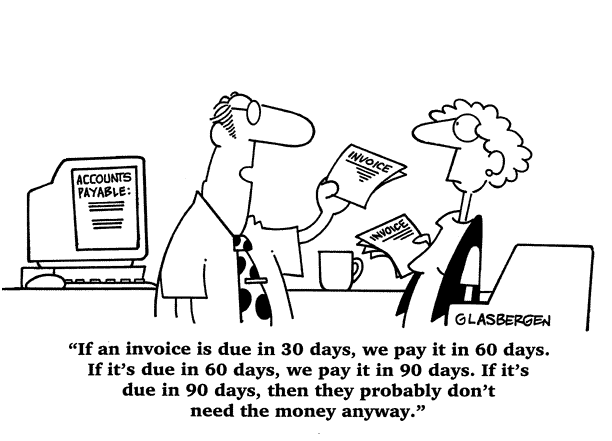 Proper cash flow management is always important for any organization. One of the most common causes of cash flow problems is poorly managed accounts receivable. Don’t assume that just because a customer purchased your product or services that they will pay you in a timely manner, or at all.
Proper cash flow management is always important for any organization. One of the most common causes of cash flow problems is poorly managed accounts receivable. Don’t assume that just because a customer purchased your product or services that they will pay you in a timely manner, or at all.
Slow paying customers may require you to draw down your cash reserves, or increase the amount of financing you need to cover your operations. As delinquent accounts get older, the probability of collecting those accounts diminishes. And of course, the more cash you have tied up in receivables, the less cash is available for running your business.
For charities and not-for-profits, slow collection of donation pledges and annual membership dues can put a strain on cash flow. While donations and membership dues are not technically accounts receivable, many of the same best practices can be applied to accelerate collections from your funding sources. Awareness of accounts receivable best practices becomes even more imperative not-for-profit organizations engaging in the sale of products and services to increase funding.
Follow these 10 best practices to improve the receivables process, which should improve cash flow and strengthen the bottom line:
1. Email Invoices
This will ensure your customers receive your invoices immediately, avoiding mail delays. Confirm with your customers which email address they wish you to send invoices to.
2. Shorten Payment Terms
In the days of paper invoices and checks, it was fairly common for businesses to extend credit to customers to allow for mail and payment delays, by granting credit terms, for example “Net 30”. However with the widespread adoption of email communication and electronic payment methods, businesses are now more commonly specifying “Payment due upon receipt”.
3. Have EFT and Other Payment Options
An increasing number of businesses are now paying their suppliers using Electronic Funds Transfer. By specifying on your invoice that payment may be made by EFT, you will enable your customer to deposit payment directly to your bank account. Simply include on your invoice your EFT banking information; bank, branch and account number. Also consider using PayPal and/or credit cards.
4. Establish Credit Policies
If you were going to extend a customer credit, it would be a good idea to assess their ability to pay. The expense of performing credit checks may be more than worthwhile for many businesses.
5. Review Accounts Receivables Regularly
Track the aging of your receivables, and systematically follow-up on any accounts that are past due more than a predetermined number of days. A good practice is to run an aged receivables report from your accounting system on a weekly basis, paying special attention to any receivables that are over, for example, 20 or 30 days old.
6. Use the Telephone
Follow-up unpaid invoices with a phone call if payment has not been received within a reasonable period. Written collection letters and even emails are usually less effective as they do not engage the customer in conversation. The fastest way to find out if there is a problem with a payment is to speak with your customer. Solving the problem in a manner that maintains a good customer relationship is also more likely if there is such a conversation.
7. Maintain a Collections Record
For each over-due account, keep a log of when follow-up calls or emails were sent, along with a record of customer’s responses to follow-up calls. Knowing that, for example, your customer promised to make a payment by a certain date will be invaluable if additional follow-up calls are required.
8. Offer Discounts for Early Payment
Payments are often made first to companies that offer discounts. The popular 2%/10, net 30 Days Terms means that if a customers pays within 10 days they receive a 2% discount, with the total due in 30 days. Try 2%/10, Net 20 Days. A customer may be less inclined to forgo a discount when the payment is due in only 10 more days anyway.
9. Use a Factoring Service
Using a factor is like selling your receivables to a third party at a discount. The costs involved with this method may be justified by greatly improving your cash flow, especially if you have a long collection cycle.
10. Use a Collection Agency
If you are unable to collect, you should submit the account to a collection agency. No one can guarantee to collect your outstanding receivables, but these companies tend to be very aggressive, and since they tend to charge based on the amounts they collect, this is a viable final option. Don’t expect to see any new business from these customers, but then they aren’t the kind of customers you want anyway.
Managing your accounts receivable is normally pretty straight forward as most customers pay on time. However, collection problems can be avoided, or at least minimized, with a strategy that considers the above best practices.



 QuickBooks for the first time, it will suggest a complex and detailed chart of accounts, typically so detailed that small business owners will often create a new account every time they are confused. Keep it simple, by minimizing your account list as much as possible.
QuickBooks for the first time, it will suggest a complex and detailed chart of accounts, typically so detailed that small business owners will often create a new account every time they are confused. Keep it simple, by minimizing your account list as much as possible.




